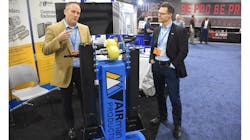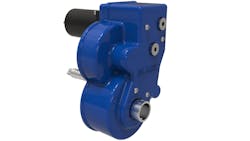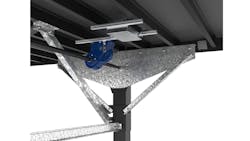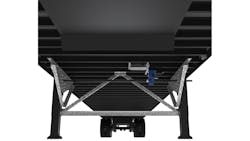AIRman Products, a manufacturer of pneumatic solutions for commercial transportation, recently revealed its new Automated Landing Gear Deployment and Retraction Technology.
With the flip of a switch, AIRman’s patent-pending device eliminates the manual cranking required to raise and lower a trailer’s landing gear, reducing driver exposure to a variety of injuries, including damage to shoulders, knees, back and upper body, the company claimed. The 15-pound, electrically driven unit can be OE-installed or retrofitted in less than an hour, and is compatible with all existing landing gear makes and models.
Using the new technology, a driver can deploy and retract landing gear in less time than it would take to do either operation manually.
“The fleets we’ve surveyed tell us that shoulder, back and rotator cuff injuries are at the top of their list for workers’ comp claims, and that cranking landing gear up and down can cause or exacerbate these injuries,” said Jim Babbitt, vice president of sales for AIRman. “Truck driving is already a physically demanding profession, so our automated system focuses on one primary stressor, making trailer drops and hookup operations safer and faster, while improving the truck driver experience and as a result, driver retention.”
The repetitive motion of cranking can tax muscles, tendons and joints, particularly with aging drivers, and the median age of truck drivers continues to rise. The Bureau of Labor Statistics estimates the average age of a commercial truck driver in the US is now 55, while, according to a driver shortage report by American Trucking Associations, the average age of an over-the-road truck driver is 46.
“Depending on the equipment and circumstances, it can take between 50 to 60 crank-arm rotations to get the legs on a trailer’s landing gear to the ground, and this task can keep some otherwise great drivers from working or coming back to work,” said Shane LaHousse, vice president of engineering for AIRman. “Operating the crank arm can be awkward and physically taxing, even if the driver is young and uses the proper technique for landing gear operation, so we’ve taken this task out of the driver equation by automating it.”
AIRman’s Automated Landing Gear Deployment and Retraction Technology also makes it possible to increase lot utilization, by enabling trailers to be parked closer together, AIRman maintained. Because no crank arm needs to be accessed, and the controller is mounted under the trailer apron, tighter trailer positioning is possible.
The system comes complete in kit form with all components and mounting hardware included. Installation requires the removal of only two bolts on the landing gear crossbar, the attachment of the AIRman landing gear actuator and the reinstallation of the crossbar.
The electrical interface is uncomplicated, requiring only a simple 12-volt power supply. The unit’s solid-state unit control box mounts under the trailer, and its two-way toggle switch user interface mounts to the side of the trailer frame rail for easy access.
Once installed, the unit requires no maintenance, except periodic replacement of its dedicated battery, as needed. AIRman’s trailer landing gear actuator is self-contained and requires no lubrication.
“Some landing gear manufacturers offer automated systems now, but they are expensive, upgrading requires discarding an existing drive leg, and if the landing gear is damaged, may require complete replacement,” Babbitt said. “Not only is the AIRman system about half the cost of other systems, it also works universally with all existing landing gear makes and models, and doesn’t have to be replaced if the landing gear is damaged.”
AIRman said it expects to commence commercial production of its Automated Landing Gear by the third quarter of 2020.
Visit airmanproducts.com/products/landinggear to learn more.



